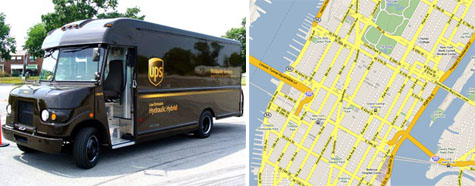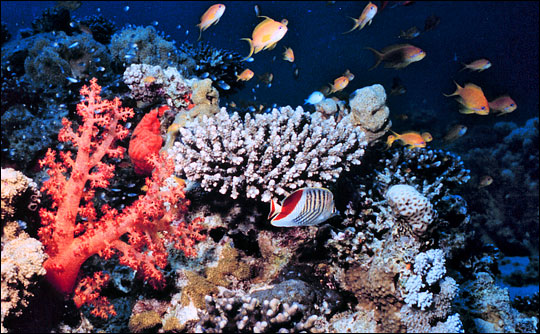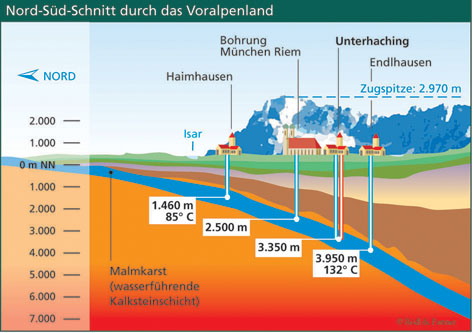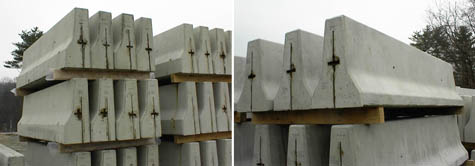Quick list 9
Can UPS save millions of dollars on truck fuel simply by cutting down on its drivers' left turns?
Apparently, the company has been trying "to re-engineer their fleet routing," the Financial Times reported last month, as a way to find more fuel-efficient modes of delivery – and part of this means they're now limiting left-hand (or cross-traffic) turns.
 As the Financial Times explained:
As the Financial Times explained:
The FT goes on to explore the fuel-use implications of just-in-time delivery; air & truck delivery vs. water & rail transport; a "computer model that would create commercial freight routes in the way that MapQuest or Google Maps make maps for motorists"; and something called Gift: the Geographic Intermodal Freight Transport model.
 Elsewhere, sudden transformations of the earth's surface, as a result of mudslides, floods, volcanic eruptions, and other topographical catastrophes, can make existing maps obsolete within seconds.
Elsewhere, sudden transformations of the earth's surface, as a result of mudslides, floods, volcanic eruptions, and other topographical catastrophes, can make existing maps obsolete within seconds.
This is precisely what happened several weeks ago when an earthquake struck on the floor of the south Pacific, off the coast of the Solomon Islands, near Australia, raising coral reefs several meters out of the water – thus killing the reefs and creating a new, sun-bleached archipelago.
"Submerged reefs that once attracted scuba divers from around the globe lie exposed and dying after the quake raised the mountainous landmass, which is 32-kilometres (20-miles) long and 8-kilometres (5-miles) wide," Seed magazine reported.
The sudden terrestrial shake-up also "revealed a sunken vessel that locals believe is a Japanese patrol boat, a remnant of the fierce fighting between Allied forces and the Japanese in WWII."
Pulp sci-fi novelists may want to bear this in mind when coming up with future storylines.
For instance: an earthquake off the coast of Chennai thrusts a submerged geological ridge into the sunlight – revealing an unexplained metallic anomaly within those slabs of shell-encrusted limestone. Scientists called in to investigate are almost immediately hospitalized after visiting the site, suffering from headaches and nosebleeds. Local fishermen report identical symptoms.
Instruments, however, record a complete absence of radiation – so there must be something else going on.
Intriguingly, the exposed metal structure appears to be growing....
Etc. etc. Like I say: pulp science fiction.
Moving on, we learn that geothermal energy is on the rise in southern Germany.
 [Image: Alpine geothermics; illustration by Rödl & Partner].
[Image: Alpine geothermics; illustration by Rödl & Partner].
According to Monocle, "Munich and its hinterland have become the new frontier for deep-seated geothermal energy":
That same issue of Monocle also points us to the "hexagonal wooden islands" of architect Vicente Guallart (whose work was previously seen on BLDGBLOG here).
This "astonishing series of artificial islands," Monocle writes, comes "in two basic forms – flat or 'hillock' – and [they] have been a great success with sunbathing locals." In the architect's own words, these create "multiple coastlines," extending seasonal fun onto previously nonexistent landforms.
 [Image: The hexagonal wooden islands of Vicente Guallart].
[Image: The hexagonal wooden islands of Vicente Guallart].
This also raises the interesting question, though, of designer terrain – or even branded landscapes, specific earthen features associated with, say, Nike or the Hilton Hotel chain – and whether or not terrestrial augmentation, such as Guallart's hexagonal wooden islands, will be the next step in boutique design. Rather than a boutique hotel, in other words, you'd have a boutique landscape.
A bit further afield, meanwhile, "shape-shifting 'smart dust' may explore alien worlds," New Scientist reports.
 [Image: Olympia Crater, Mars; courtesy of NASA/JPL-Caltech/Cornell].
[Image: Olympia Crater, Mars; courtesy of NASA/JPL-Caltech/Cornell].
Finally, for now, it was announced this week that the US military "is building a three-mile concrete wall in the centre of Baghdad along the most murderous faultline between Sunni and Shia Muslims."
 [Images: Concrete barriers (with no connection to Baghdad)].
[Images: Concrete barriers (with no connection to Baghdad)].
Adding to the tactical surreality of this decision – after all, building a wall to separate warring neighborhoods will almost certainly result in more extreme mortar attacks and general social distrust – we find this glimpse of architectural construction under continuous military guard:
More soon – and happy Earth Day, by the way.
(With two of these links found via Leah Beeferman and Telstar Logistics. Earlier on BLDGBLOG: Quick list 8 – and onward from there...).
Apparently, the company has been trying "to re-engineer their fleet routing," the Financial Times reported last month, as a way to find more fuel-efficient modes of delivery – and part of this means they're now limiting left-hand (or cross-traffic) turns.
 As the Financial Times explained:
As the Financial Times explained:- [I]nformation technology has an important role to play in making existing vehicles more efficient, particularly when it comes to aggregating small gains across large fleets. Take something as simple as reducing left-hand turns. For US drivers, this means less time idling in the middle of the road waiting for oncoming traffic to pass.
The FT goes on to explore the fuel-use implications of just-in-time delivery; air & truck delivery vs. water & rail transport; a "computer model that would create commercial freight routes in the way that MapQuest or Google Maps make maps for motorists"; and something called Gift: the Geographic Intermodal Freight Transport model.
 Elsewhere, sudden transformations of the earth's surface, as a result of mudslides, floods, volcanic eruptions, and other topographical catastrophes, can make existing maps obsolete within seconds.
Elsewhere, sudden transformations of the earth's surface, as a result of mudslides, floods, volcanic eruptions, and other topographical catastrophes, can make existing maps obsolete within seconds. This is precisely what happened several weeks ago when an earthquake struck on the floor of the south Pacific, off the coast of the Solomon Islands, near Australia, raising coral reefs several meters out of the water – thus killing the reefs and creating a new, sun-bleached archipelago.
"Submerged reefs that once attracted scuba divers from around the globe lie exposed and dying after the quake raised the mountainous landmass, which is 32-kilometres (20-miles) long and 8-kilometres (5-miles) wide," Seed magazine reported.
The sudden terrestrial shake-up also "revealed a sunken vessel that locals believe is a Japanese patrol boat, a remnant of the fierce fighting between Allied forces and the Japanese in WWII."
Pulp sci-fi novelists may want to bear this in mind when coming up with future storylines.
For instance: an earthquake off the coast of Chennai thrusts a submerged geological ridge into the sunlight – revealing an unexplained metallic anomaly within those slabs of shell-encrusted limestone. Scientists called in to investigate are almost immediately hospitalized after visiting the site, suffering from headaches and nosebleeds. Local fishermen report identical symptoms.
Instruments, however, record a complete absence of radiation – so there must be something else going on.
Intriguingly, the exposed metal structure appears to be growing....
Etc. etc. Like I say: pulp science fiction.
Moving on, we learn that geothermal energy is on the rise in southern Germany.
 [Image: Alpine geothermics; illustration by Rödl & Partner].
[Image: Alpine geothermics; illustration by Rödl & Partner].According to Monocle, "Munich and its hinterland have become the new frontier for deep-seated geothermal energy":
- Drilling three to four kilometres into the earth's crust allows engineers to tap into boiling hot water, which can be used to heat buildings and run zero-emission power plants. The southernmost past of the state of Bavaria, along the Alps' foothills, is the literal hotbed of geothermal exploration, with planned investments of €3.2bn.
That same issue of Monocle also points us to the "hexagonal wooden islands" of architect Vicente Guallart (whose work was previously seen on BLDGBLOG here).
This "astonishing series of artificial islands," Monocle writes, comes "in two basic forms – flat or 'hillock' – and [they] have been a great success with sunbathing locals." In the architect's own words, these create "multiple coastlines," extending seasonal fun onto previously nonexistent landforms.
 [Image: The hexagonal wooden islands of Vicente Guallart].
[Image: The hexagonal wooden islands of Vicente Guallart]. This also raises the interesting question, though, of designer terrain – or even branded landscapes, specific earthen features associated with, say, Nike or the Hilton Hotel chain – and whether or not terrestrial augmentation, such as Guallart's hexagonal wooden islands, will be the next step in boutique design. Rather than a boutique hotel, in other words, you'd have a boutique landscape.
A bit further afield, meanwhile, "shape-shifting 'smart dust' may explore alien worlds," New Scientist reports.
- Thousands of miniscule wireless sensors, or "smart dust", could one-day be used to explore other planets, swirling across the landscape by subtly altering their shape.
 [Image: Olympia Crater, Mars; courtesy of NASA/JPL-Caltech/Cornell].
[Image: Olympia Crater, Mars; courtesy of NASA/JPL-Caltech/Cornell]. Finally, for now, it was announced this week that the US military "is building a three-mile concrete wall in the centre of Baghdad along the most murderous faultline between Sunni and Shia Muslims."
- The wall, which recognises the reality of the hardening sectarian divide in Baghdad, is a central part of George Bush's final push to pacify the capital. Work began on April 10 under cover of darkness and is due for completion by the end of the month... Although Baghdad is full of barriers and checkpoints, particularly round the Green Zone where the US and British are based along with the Iraq government, this is the first time a wall has been built along sectarian lines. Its construction comes as the security situation appears to be deteriorating despite the recent US troop "surge".
 [Images: Concrete barriers (with no connection to Baghdad)].
[Images: Concrete barriers (with no connection to Baghdad)]. Adding to the tactical surreality of this decision – after all, building a wall to separate warring neighborhoods will almost certainly result in more extreme mortar attacks and general social distrust – we find this glimpse of architectural construction under continuous military guard:
- The Baghdad wall, which will be 12ft (3.5 metres) high, is being built by US paratroopers who left Camp Taji, about 20 miles north of the city, on the first night in a dozen trucks carrying stacks of huge concrete barriers, each weighing 14,000 pounds (6,300kg). Cranes, protected by tanks, winched them into place. Building has continued every night since.
More soon – and happy Earth Day, by the way.
(With two of these links found via Leah Beeferman and Telstar Logistics. Earlier on BLDGBLOG: Quick list 8 – and onward from there...).





Comments are moderated.
If it's not spam, it will appear here shortly!
I think you should read Michael Crighton's "Prey".
Michael always researches his subjects thoroughly and from interesting viewpoints, the result usually being thought provoking, gripping books.
"Prey" is set in a lab that manufactures "nano bots" the size of dust particles, as you described, and what happens when a swarm suddenly goes renegade.
However, this is not merely some cheap horror story, as it features some interesting insights into the science behind nano technology and the inherent implications.
Good read if you have the time.
I love that mysteriously revealed metal...
Thank you for sharing.
Nathalie
i haven't read 'prey,' but neal stephenson beat him to it by two years. 'the diamond age,' details nanostorms, warring clouds of nanobots filling the air of cities like the soot and carbon of the industrial age, and almost spontaneous human combustion caused by a character's nanobot enhanced immune system warring against nanite invaders in her bloodstream.
awesome.
After a dip a hot springs and some fine off-roading just outside Mammoth CA, we found this
http://www.mammothpacific.com/
And I thought it was only the Germans!
Neal Stephenson also wrote "Cryptonomicon", right?
He's another fiction author who I have found researches exhaustively and has an interesting take on things.
However, I think his writing style still leaves something to be desired.
There is a whole chapter, around 20 pages, in "Cryptonomicon" in which he describes the main character eating a a bowl of cereal, and it is in no way significant to the plot. I found it excruciating.
"This also raises the interesting question, though, of designer terrain "
This comment leads me to believe you haven't seen what is going on in Dubai - which I find hard to believe given the depth of your blog. Just in case here is a link. If this isn't designer (well the word designer is debatable, but may work in this instance) terrain I don't know what is.
"the kind of sand that the artists call polychrome, because of its many colours, is actually not sand at all, but the glass of the past, now pounded to powder by ages of tumbling in the clamorous sea."--Gene Wolfe, The Book of the New Sun
Geoff,
Designer terrain strikes me as simply one more way to stress the natural environment.
As for the Baghdad wall, there's an interesting article in the May National Geographic on barriers along the US-Mexico border. The piece discusses the limited success of other such dividers: China's Great Wall, Hadrian's Wall, the Maginot Line, &c.
isabella, Firefox has a thing under "Preferences" where you can block images that don't originate with the site you're visiting; make sure that isn't ticked, and you should be fine.
Post a Comment